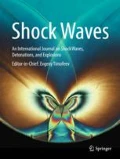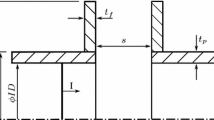Abstract
During previous investigations on pseudo-shock systems, we have observed reproducible differences between measurement and simulations for the pressure distribution as well as for size and shape of the pseudo-shock system. A systematic analysis of the deviations leads to the conclusion that small gaps of \(\Delta z=O(10^{-4})\) m between quartz glass side walls and metal contour of the test section are responsible for this mismatch. This paper describes a targeted experimental and numerical study of the bypass mass flow within these gaps and its interaction with the main flow. In detail, we analyze how the pressure distribution within the channel as well as the size, shape and oscillation of the pseudo-shock system are affected by the gap size. Numerical simulations are performed to display the flow inside the gaps and to reproduce and explain the experimental results. Numerical and experimental schlieren images of the pseudo-shock system are in good agreement and show that especially the structure of the primary shock is significantly altered by the presence of small gaps. Extensive unsteady flow simulations of the geometry with gaps reveal that the shear layer between subsonic gap flow and supersonic core flow is subject to a Kelvin–Helmholtz instability resulting in small pressure fluctuations. This leads to a shock oscillation with a frequency of \(f= O(10^5) \hbox {s}^{-1}\). The corresponding time scale \(\tau \) (s) is 16 times higher than the characteristic time scale \(\tau _\delta =\delta /U_\infty \) of the boundary layer given by the ratio of the boundary layer thickness \(\delta \) directly ahead of the shock and the undisturbed free stream velocity \(U_\infty \). To assess the reliability of our numerical investigations, the paper includes a grid study as well as an extensive comparison of several RANS turbulence models and their impact on the predicted shape of pseudo-shock systems.























Similar content being viewed by others
References
Grzona, A., Weiss, A., Olivier, H., Gawehn, T., Gülhan, A., Al-Hasan, N.S., Schnerr, G.H., Abdali, A., Luong, M., Wiggers, H., Schulz, C., Chun, J., Weigand, B., Winnemöller, T., Schröder, W., Rakel, T., Schaber, K., Goertz, V., Nirschl, H., Maisels, A., Leibold, W., Dannehl, M.: Gas-phase synthesis of non-agglomerated nanoparticles by fast gasdynamic heating and cooling. In: 26th International Symposium on Shock Waves, pp. 857–862. Springer, Berlin (2009)
Giglmaier, M., Al-Hasan, N.S., Adams, N.A.: 3-D simulation of the production of gas-phase synthesized non-aggregated spherical nano-particles in continuous gasdynamic flow particle-laden flows. In: Proceedings of the 7th International Conference on Multiphase Flow, ICMF 2010
Gawehn, T., Gülhan, A., Al-Hasan, N.S., Schnerr, G.H.: Experimental and numerical analysis of the structure of pseudo-shock systems in laval nozzles with parallel side walls. In: 27th International Symposium on Shock Waves, vol. 20, pp. 297–306. Springer, Berlin (2010)
Weiss, A., Grzona, A., Olivier, H.: Behavior of shock trains in a diverging duct. Exp. Fluids 49, 355–365 (2010)
Gawehn, T., Gülhan, A., Al-Hasan, N.S., Giglmaier, M., Adams, N.A.: Analysis of pseudo-shock system structure and asymmetry in laval nozzles with parallel side walls. In: 19th International Shock Interaction Symposium, ISIS19 (2010)
Gawehn, T., Giglmaier, M., Quaatz, J.F., Gülhan, A., Adams, N.A.: Pseudo-shock system structure in rectangular laval nozzles with gaps. In: 28th International Symposium on Shock Waves, pp. 165–170. Springer, Berlin (2012)
Al-Hasan, N.S., Schnerr, G.H.: Aerodynamic optimization of Laval nozzle flow with shocks: numerical investigation of active/passive shock control via expansion fans. PAMM 7(1), 4110003–4110004 (2007)
Weiss, A., Olivier, H.: Behaviour of a shock train under the influence of boundary-layer suction by a normal slot. Exp. Fluids 52, 273–287 (2012)
Weiss, A., Olivier, H.: Shock boundary layer interaction under the influence of a normal suction slot. Shock Waves (2012, accepted for publication)
Weiss, A., Olivier, H.: Influence of a normal slot boundary layer suction system onto a shock train. In: 28th International Symposium on Shock Waves, pp. 141–146. Springer, Berlin (2012)
Grzona, A., Olivier, H.: Shock train generated turbulence inside a nozzle with a small opening angle. Exp. Fluids 51, 621–639 (2011)
Grzona, A., Olivier, H.: Experimental investigation of shock train induced turbulence. In: 28th International Symposium on Shock Waves, pp. 135–140. Springer, Berlin (2012)
Sun, L., Sugiyama, H., Mizobata, K., Minato, R., Tojo, A.: Numerical and experimental investigations on Mach 2 and 4 pseudo-shock waves in a square duct. Jpn. Soc. Aeronaut. Space Sci. Trans. 47, 124–130 (2005)
Sun, L.Q., Sugiyama, H., Mizobata, K., Fukuda, K.: Numerical and experimental investigations on the Mach 2 pseudo-shock wave in a square duct. J. Vis. 6(4), 363–370 (2003)
Xiao, Q., Tsai, H.M., Papamoschou, D.: Numerical investigation of supersonic nozzle flow separation. AIAA J. 45(3), 532–541 (2007)
Carroll, B.F., Dutton, J.C.: Characteristics of multiple shock wave/turbulent boundary-layer interactions in rectangular ducts. J. Propuls. Power 6(2), 186–193 (1990)
Carroll, B.F., Dutton, J.C.: Turbulence phenomena in a multiple normal shock wave/turbulent boundary layer interaction. AIAA J. 30(1), 43–48 (1992)
Johnson, A.D., Papamoschou, D.: Instability of shock-induced nozzle flow separation. Phys. Fluids 22(1), 016102 (2010)
Matsuo, K., Miyazato, Y., Kim, H.-D.: Shock train and pseudo-shock phenomena in internal gas flows. Prog. Aerosp. Sci. 35(1), 33–100 (1999)
http://www.ansys.com/Products/Simulation20Technology/Fluid20Dynamics/ANSYS20CFX
ANSYS CFX-solver theory guide, 12.1 edn (2009)
Spalart, P.R., Allmaras, S.R.: A one equation turbulence model for aerodynamic flows, AIAA Paper 92–439, AIAA (1992)
Jones, W.P., Launder, B.E.: The prediction of laminarization with a two-equation model of turbulence. Int. J. Heat Mass Transf. 15(2), 301–314 (1972)
Wilcox, D.C.: Multiscale model for turbulent flows. In: 24th AIAA Aerospace Sciences Meeting (1986)
Menter, F.R.: Two-equation eddy-viscosity turbulence models for engineering applications. AIAA J. 32(8), 1598–1605 (1994)
Wallin, S., Johansson, A.V.: An explicit algebraic Reynolds stress model for incompressible and compressible turbulent flows. J. Fluid Mech. 403, 89–132 (2000)
Hellsten, A.: New advanced k-\(\omega \) turbulence model for high lift aerodynamics, AIAA Paper 2004–1120 (2004)
Wilcox, D.C.: Turbulence modeling for CFD, 2nd edn. DCW Industries, Inc (1998)
Launder, B.E., Reece, G.J., Rodi, W.: Progress in the development of a Reynolds-stress turbulence closure. J. Fluid Mech. 68, 537–566 (1975)
Speziale, C.G., Sarkar, S., Gatski, T.B.: Modelling the pressure-strain correlation of turbulence—an invariant dynamical systems approach. J. Fluid Mech. 227, 245–272 (1991)
Bogar, T.J., Kroutil, J.C., Sajben, M.: Characteristic frequencies of transonic diffuser flow oscillations. AIAA J. 21, 1232–1240 (1983)
Matsuo, K., Mochizuki, H., Miyazato, Y., Gohya, M.: Oscillatory characteristics of a pseudo-shock wave in a rectangular straight duct. JSME Int. J. Ser. B Fluids Therm. Eng. 36(2), 222–229 (1993)
Bourgoing, A., Reijasse, P.: Experimental analysis of unsteady separated flows in a supersonic planar nozzle. Shock Waves 14, 251–258 (2005)
Matsuo, K., Kim, H.D.: Normal shock wave oscillations in supersonic diffusers. Shock Waves 3, 25–33 (1993)
Dolling, D.S., Or, C.T.: Unsteadiness of the shock wave structure in attached and separated compression ramp flows. Exp. Fluids 3, 24–32 (1985)
Hadjadj, A., Dussauge, J.-P.: Shock wave boundary layer interaction. Shock Waves 19, 449–452 (2009)
Grilli, M., Schmid, P.J., Hickel, S., Adams, N.A.: Analysis of unsteady behaviour in shockwave turbulent boundary layer interaction. J. Fluid Mech. 700, 16–28 (2012)
Acknowledgments
The support of the German Research Foundation (DFG) by grant PAK 75/2 “Gasdynamically induced particle production” is gratefully acknowledged. Computer resources for this project have been provided by the Leibniz Supercomputing Centre.
Author information
Authors and Affiliations
Corresponding author
Additional information
Communicated by A. Sasoh.
This work was presented at the 28th International Symposium on Shock Waves, 17–22 July 2011, Manchester, UK.
Appendices
Appendix A: Geometry
The geometry of the calculated domain is given in Table 1. Between the sections C–D, D–E, G–H and H–I are fillets of \(r\) = 200 mm. The corner of the rectangular cross section of H and I is rounded by a fillet. The domain ends at \(x\) = 865.56 mm with a fillet of \(r\) = 5 mm and a cross section of \(A=464.657 \hbox {mm}^2\).
The critical cross section B–C is prescribed by (3)
with the following constants:
Appendix B: Wall temperature
According to the measurements, the wall temperature in the simulation is prescribed by (4) (\(x\) in (mm))
with the following constants:
Rights and permissions
About this article
Cite this article
Giglmaier, M., Quaatz, J.F., Gawehn, T. et al. Numerical and experimental investigations of pseudo-shock systems in a planar nozzle: impact of bypass mass flow due to narrow gaps. Shock Waves 24, 139–156 (2014). https://doi.org/10.1007/s00193-013-0475-2
Received:
Revised:
Accepted:
Published:
Issue Date:
DOI: https://doi.org/10.1007/s00193-013-0475-2




